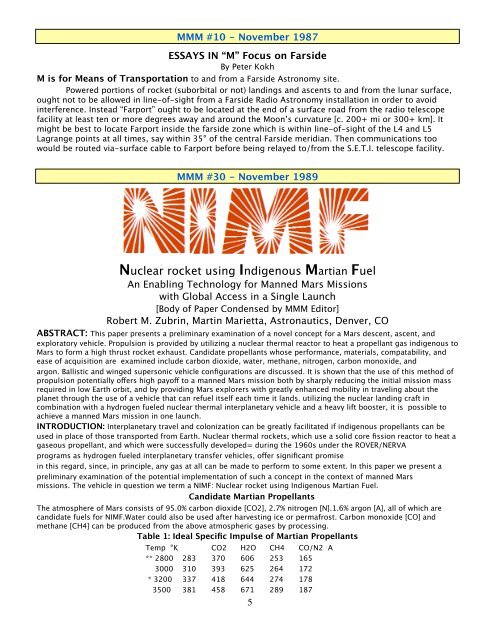Space Transportation - mmmt_transportation.pdf - Moon Society
Space Transportation - mmmt_transportation.pdf - Moon Society
Space Transportation - mmmt_transportation.pdf - Moon Society
You also want an ePaper? Increase the reach of your titles
YUMPU automatically turns print PDFs into web optimized ePapers that Google loves.
MMM #10 - November 1987<br />
ESSAYS IN “M” Focus on Farside<br />
By Peter Kokh<br />
M is for Means of <strong>Transportation</strong> to and from a Farside Astronomy site.<br />
Powered portions of rocket (suborbital or not) landings and ascents to and from the lunar surface,<br />
ought not to be allowed in line-of-sight from a Farside Radio Astronomy installation in order to avoid<br />
interference. Instead “Farport” ought to be located at the end of a surface road from the radio telescope<br />
facility at least ten or more degrees away and around the <strong>Moon</strong>’s curvature [c. 200+ mi or 300+ km]. It<br />
might be best to locate Farport inside the farside zone which is within line-of-sight of the L4 and L5<br />
Lagrange points at all times, say within 35° of the central Farside meridian. Then communications too<br />
would be routed via-surface cable to Farport before being relayed to/from the S.E.T.I. telescope facility.<br />
MMM #30 - November 1989<br />
Nuclear rocket using Indigenous Martian Fuel<br />
An Enabling Technology for Manned Mars Missions<br />
with Global Access in a Single Launch<br />
[Body of Paper Condensed by MMM Editor]<br />
Robert M. Zubrin, Martin Marietta, Astronautics, Denver, CO<br />
ABSTRACT: This paper presents a preliminary examination of a novel concept for a Mars descent, ascent, and<br />
exploratory vehicle. Propulsion is provided by utilizing a nuclear thermal reactor to heat a propellant gas indigenous to<br />
Mars to form a high thrust rocket exhaust. Candidate propellants whose performance, materials, compatability, and<br />
ease of acquisition are examined include carbon dioxide, water, methane, nitrogen, carbon monoxide, and<br />
argon. Ballistic and winged supersonic vehicle configurations are discussed. It is shown that the use of this method of<br />
propulsion potentially offers high payoff to a manned Mars mission both by sharply reducing the initial mission mass<br />
required in low Earth orbit, and by providing Mars explorers with greatly enhanced mobility in traveling about the<br />
planet through the use of a vehicle that can refuel itself each time it lands. utilizing the nuclear landing craft in<br />
combination with a hydrogen fueled nuclear thermal interplanetary vehicle and a heavy lift booster, it is possible to<br />
achieve a manned Mars mission in one launch.<br />
INTRODUCTION: Interplanetary travel and colonization can be greatly facilitated if indigenous propellants can be<br />
used in place of those transported from Earth. Nuclear thermal rockets, which use a solid core fission reactor to heat a<br />
gaseous propellant, and which were successfully developed= during the 1960s under the ROVER/NERVA<br />
programs as hydrogen fueled interplanetary transfer vehicles, offer significant promise<br />
in this regard, since, in principle, any gas at all can be made to perform to some extent. In this paper we present a<br />
preliminary examination of the potential implementation of such a concept in the context of manned Mars<br />
missions. The vehicle in question we term a NIMF: Nuclear rocket using Indigenous Martian Fuel.<br />
Candidate Martian Propellants<br />
The atmosphere of Mars consists of 95.0% carbon dioxide [CO2], 2.7% nitrogen [N].1.6% argon [A], all of which are<br />
candidate fuels for NIMF.Water could also be used after harvesting ice or permafrost. Carbon monoxide [CO] and<br />
methane [CH4] can be produced from the above atmospheric gases by processing.<br />
Table 1: Ideal Specific Impulse of Martian Propellants<br />
Temp °K CO2 H2O CH4 CO/N2 A<br />
** 2800 283 370 606 253 165<br />
3000 310 393 625 264 172<br />
* 3200 337 418 644 274 178<br />
3500 381 458 671 289 187<br />
5















